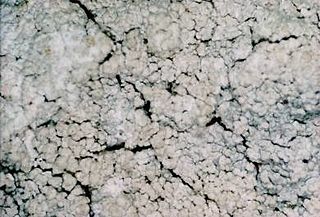
Lepraria is a genus of leprose (powdery) crustose lichens that grows on its substrate like patches of granular, caked up, mealy dust grains. Members of the genus are commonly called dust lichens. The main vegetative body (thallus) is made of patches of soredia. There are no known mechanisms for sexual reproduction, yet members of the genus continue to speciate. Some species can form marginal lobes and appear squamulose. Because of the morphological simplicity of the thallus and the absence of sexual structures, the composition of lichen products are important characters to distinguish between similar species in Lepraria.

Leprocaulon is a genus of lichen-forming fungi in the family Leprocaulaceae. Members of the genus Leprocaulon are commonly called mealy lichens.
Lepraria pacifica, the Pacific dust lichen, is a whitish-blue-green leprose crustose lichen that grows on its substrate like patches of granular, caked-up, mealy dust grains. Like other members of the Lepraria genus, it only reproduces asexually.

Leprocaulaceae is a family of mostly lichen-forming fungi. It is the single family in the monotypic order Leprocaulales. Leprocaulaceae contains three genera and about 33 species.

Lepraria incana is a species of dust lichen in the family Stereocaulaceae. First described scientifically by Johann Jacob Dillenius in 1741, and then formally by Carl Linnaeus in 1753, it is the type species of the genus Lepraria. The thallus of this species is green to greyish-green, and powdery – as if made of tiny granules. These granules are soredia, which are asexual reproductive structures. Like most members of genus Lepraria, the lichen has few distinguishing features, lacking both a medulla and sexual reproductive structures (apothecia). Chemically, the lichen is characterised by the presence of the secondary chemicals known as divaricatic acid and zeorin.

Lepraria harrisiana is a species of leprose lichen in the family Stereocaulaceae. It is widespread in the eastern United States where it occurs in humid habitats, such as conifer swamps and riparian forests.
Lepraria atlantica is a species of leprose lichen in the family Stereocaulaceae. Described as a new species in 2001, the lichen occurs in Australia, Europe, and Greenland, where it typically grows over rocks and associated mosses.
Lepraria caesioalba is a widely distributed species of leprose lichen in the family Stereocaulaceae.
Lepraria achariana is a species of leprose lichen in the family Stereocaulaceae. It occurs at high elevations in Bolivia.
Lepraria alpina is a species of leprose lichen in the family Stereocaulaceae. It is found in Europe, North and South America, Antarctica, and Greenland, where it typically grows on rocks and rock-dwelling mosses in cool habitats.
Lepraria celata is a species of leprose lichen in the family Stereocaulaceae. The powdery greyish-green lichen, described as a new species in 2006, occurs in eastern Europe.
Lepraria borealis is a species of leprose lichen in the family Stereocaulaceae, found in cool climates across Northern Europe, northwestern North America, Greenland, and Antarctica. It primarily grows on acidic rock and moss-covered surfaces, occasionally occurring on soil or other lichens. The species forms a granular crust with abundant soredia and shows considerable chemical variation, typically containing atranorin and rangiformic acid.

Lepraria caesiella is a species of leprose lichen in the family Stereocaulaceae. It forms a thin, gray-blue powdery crust composed of granular aggregations and lacks a true cortex or lobes. The species is widespread throughout northeastern North America, occurring primarily on tree bark, especially hardwoods like oaks, though it can also be found on non-calcareous rocks in sheltered locations. It was formally described by Richard C. Harris in 2005 and is characterized by its production of atranorin, zeorin, and pallidic acid. phylogenetics studies have helped distinguish it from the morphologically similar L. harrisiana, which was previously considered part of the same species.
Leprocaulon coriense is a species of leprose lichen in the family Stereocaulaceae. It is found in Asia and Australia where it grows on various substrates, including rock, wood, bark, mosses and soil.
Lepraria crassissima is a species of leprose lichen in the family Stereocaulaceae. It occurs in Australia and Europe, when it grows on rocks and on mosses growing on rocks.
Lepraria elobata is a species of leprose lichen in the family Stereocaulaceae. It occurs in Europe, North America, and Greenland. The bluish- to greenish-grey, powdery lichen grows on bark and sometimes on soil, wood, siliceous rock and mosses, usually in shady and humid habitats.

Lepraria friabilis is a species of leprose lichen in the family Stereocaulaceae. It has a disjunct distribution in the southeastern United States and southern California, where it grows exclusively on coniferous bark in humid environments such as swamps and stream valleys.
Lepraria gelida is a species of leprose lichen in the family Stereocaulaceae. It occurs in Greenland, Svalbard and the Russian Arctic islands, where it grows on soil, mosses and sometimes lichens, and rarely on bark.
Lepraria goughensis is a little-known species of leprose lichen in the family Stereocaulaceae. It is only known to occur on Gough Island in the south Atlantic Ocean.
Lepraria humida is a species of leprose lichen in the family Stereocaulaceae. Found in northern Europe and northeastern North America, it grows on siliceous rocks, often between mosses, typically on rain-sheltered damp surfaces.






